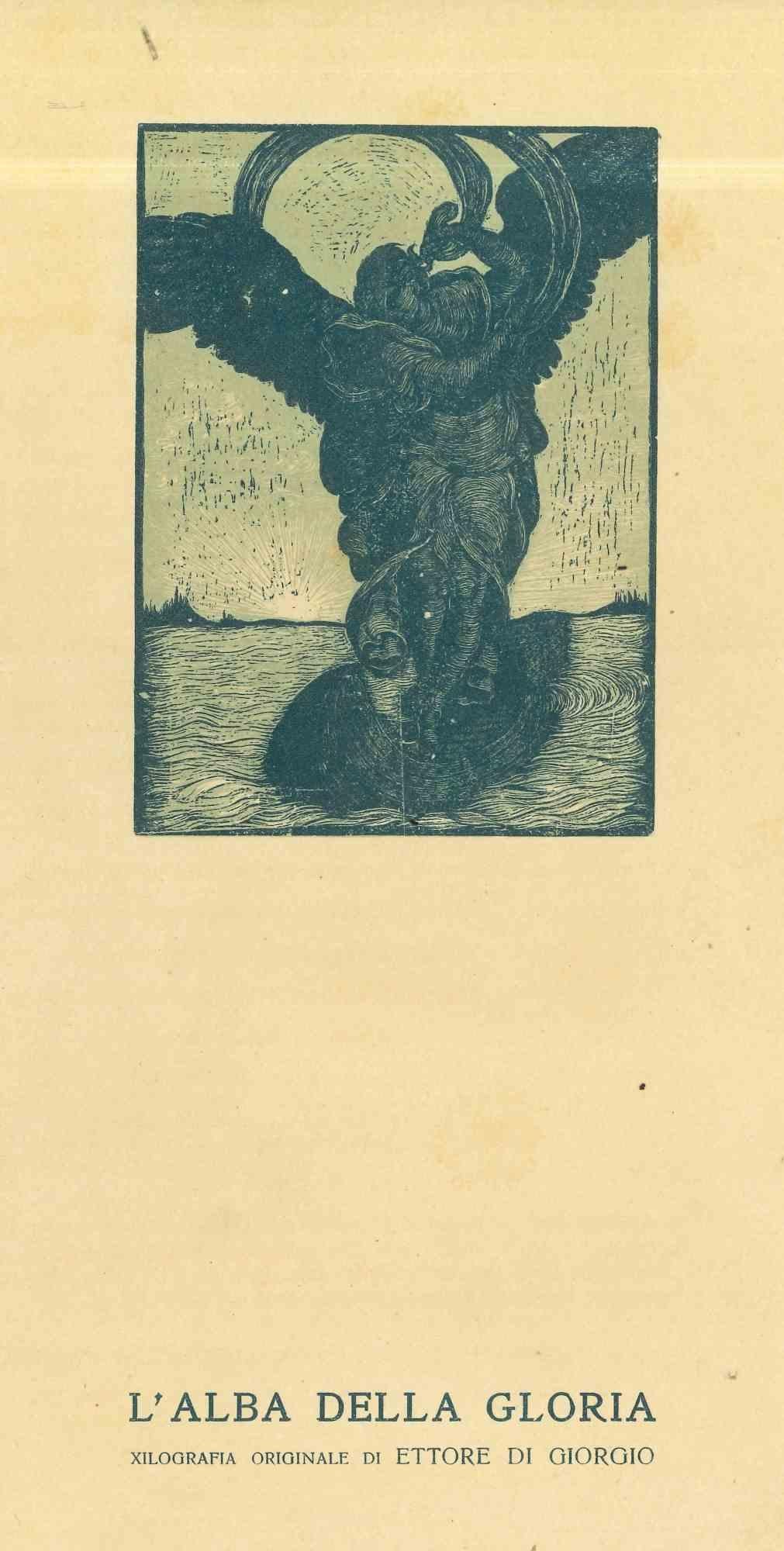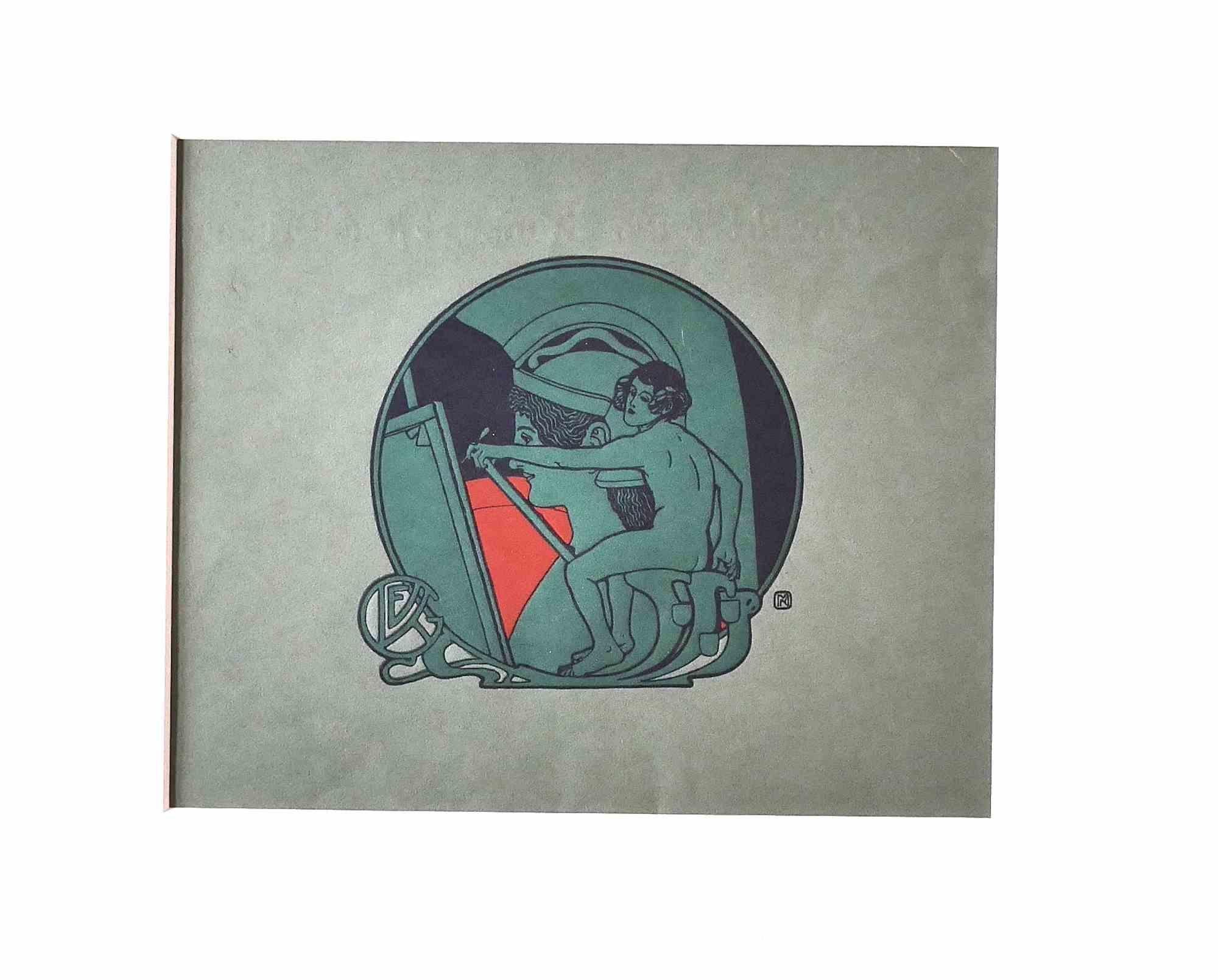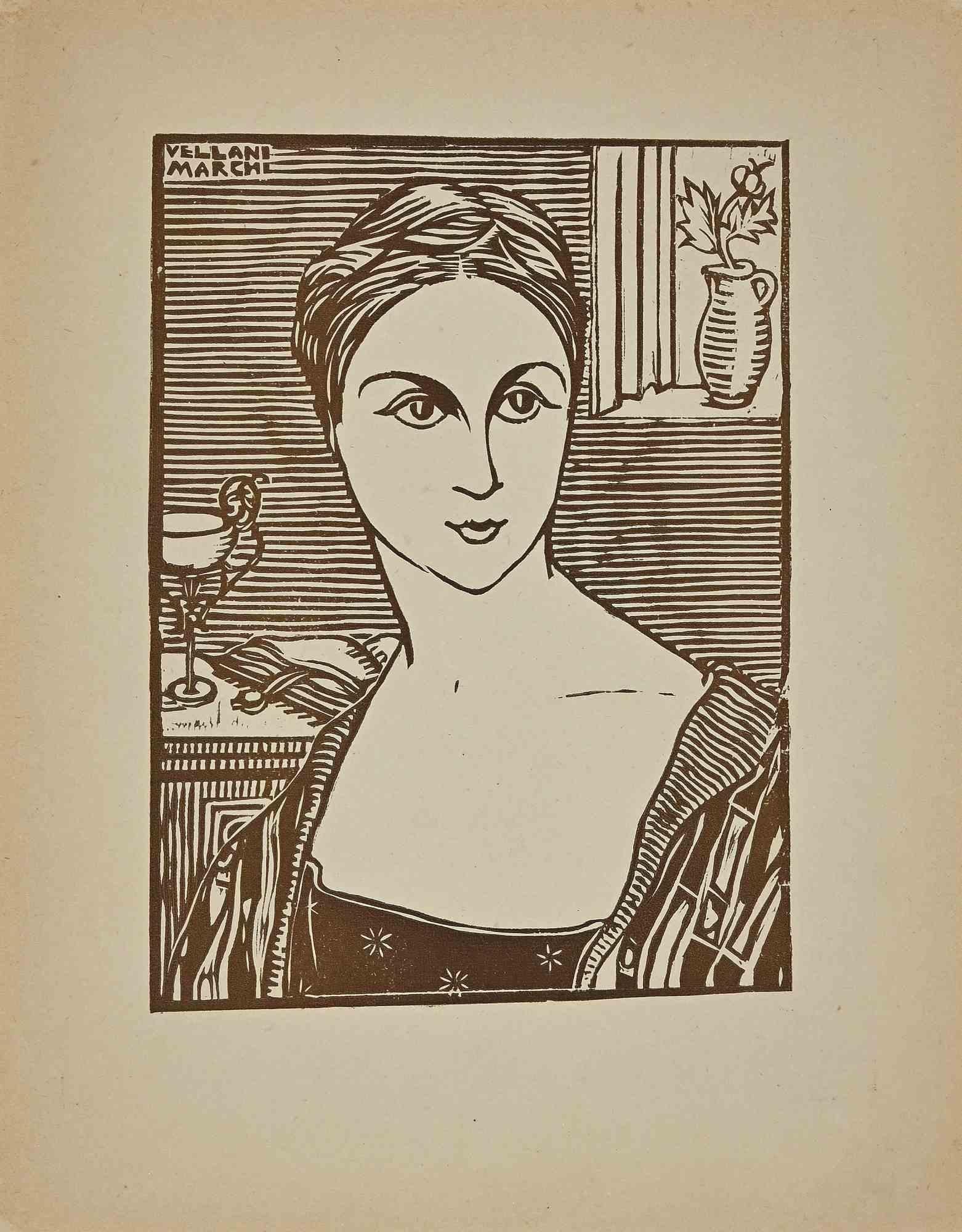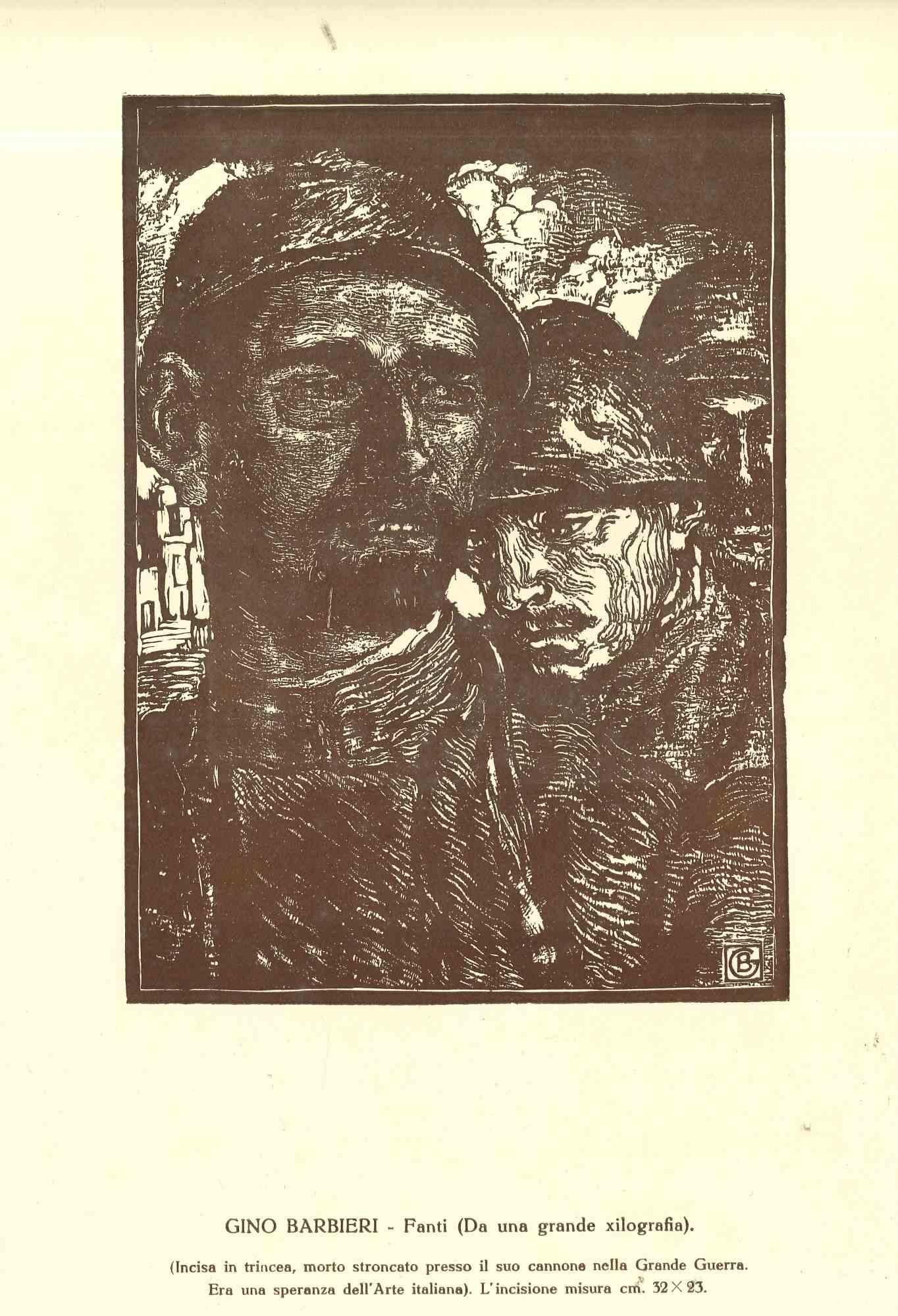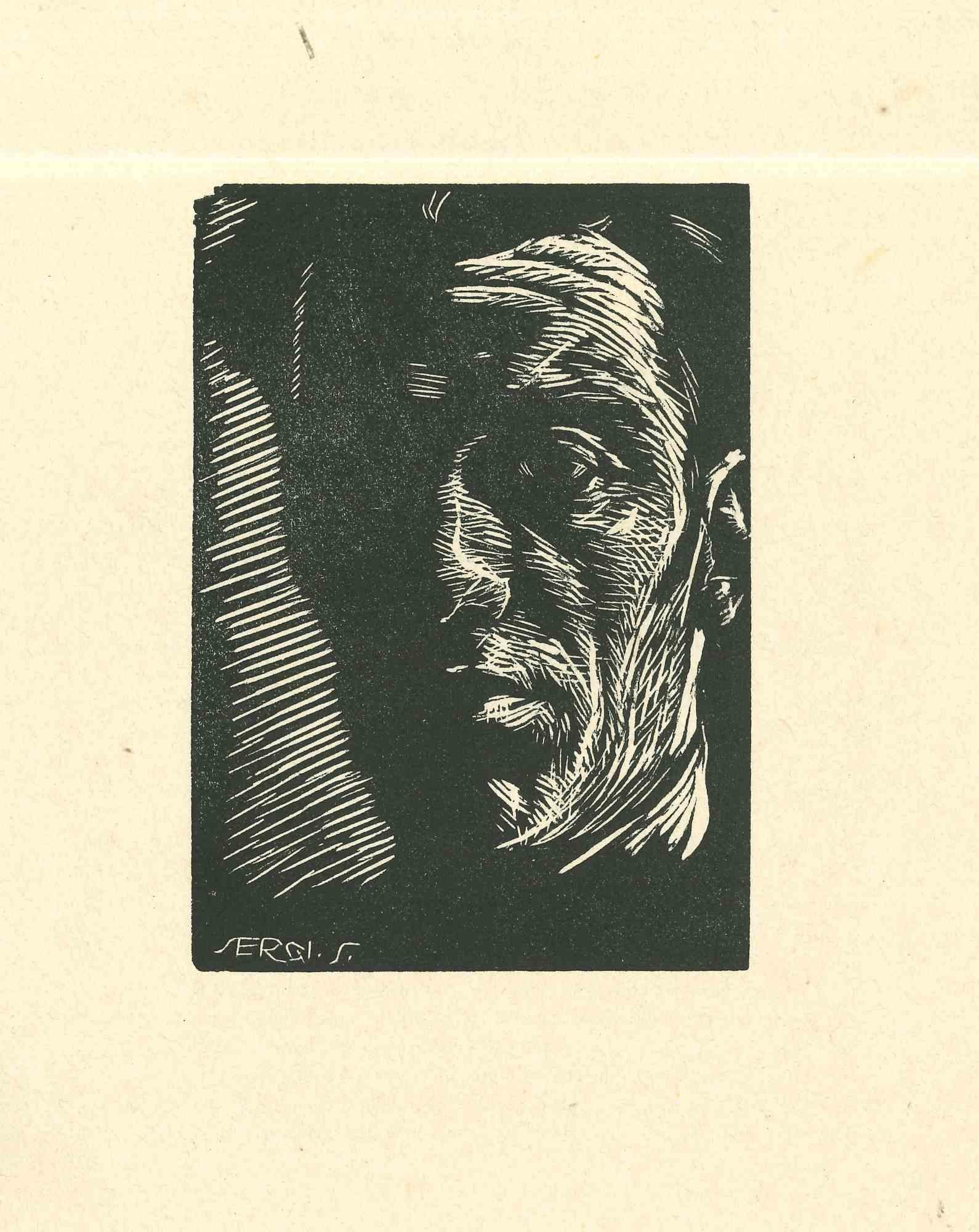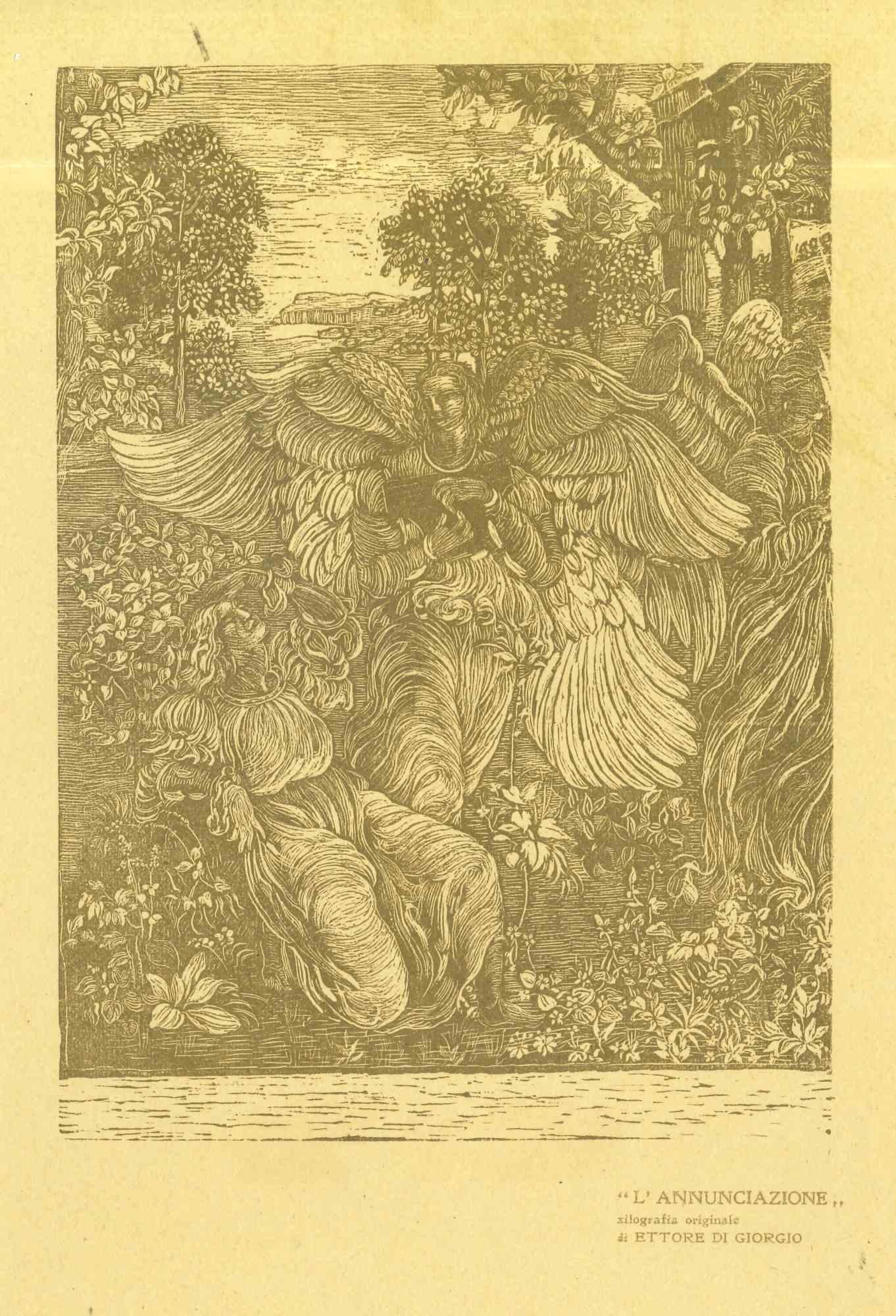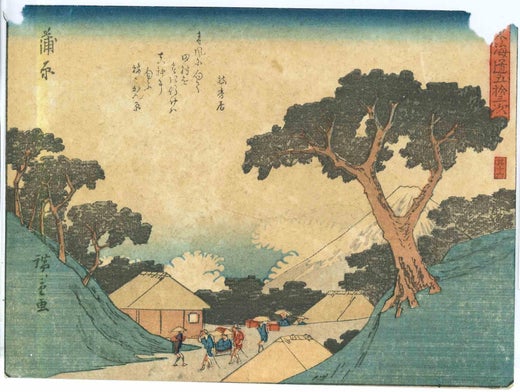Items Similar to Kambara - 53 Stations of the Tokaido - Woodcut by Utagawa Hiroshige - 1842
Want more images or videos?
Request additional images or videos from the seller
1 of 2
Utagawa HiroshigeKambara - 53 Stations of the Tokaido - Woodcut by Utagawa Hiroshige - 18421842
1842
About the Item
Kambara is a polychrome woodblock print (ink and colour on paper) by Utagawa Hiroshige (Japanese, 1797-1858). The plate n. 16, from the print suite Fifty-three Stations Along the Tokaido Road (Tôkaidô gojûsan tsugi no uchi), also known as the First Tôkaidô or Great Tôkaidô. Published by Takenouchi Magohachi (Hoeidô) during the Edo.
Signed on plate and in a cartouche “Hiroshige ga”???.
With the marks of the Censor's seal: kiwame ??:?
Horizontal Oban. In fair condition, with vivid colors, this plate has some visible aging signs (yellowing of the paper, discolorations and abrasions). Although some thinner areas and some lacks on the higher corners of the sheet, this ukiyo-e print has preserved still today its beauty and charme.
This plate, as well all the plates of the whole print suite, was designed by the ukiyo-e old master, Utagawa Hiroshige, around 1833-34, after his travel along the Tokaido in 1832.
CATALOGUE RAISONNÉ: Ukiyo-e shûka 14 (1981), Hiroshige list, p. 245, horizontal ôban #55.16.
Collect this superb ukiyo-e, depicting a pleasant Asian landscape animatewd by workers, to embellish your house with a sophisticated Oriental touch!
The Fifty-Three Stations of the Tokaido is a series of ukiyo-e woodcut prints created by Utagawa Hiroshige after his first travel along the Tokaido in 1832. The Fifty-Three Stations of the Tokaido was such a popular subject that led Hiroshige to create some 30 series of woodcut prints on it, all very different one from the other by their size (oban or chuban), their designs or even their number (some series include just a few prints).
The Tokaido road, linking the shogun's capital, Edo, to the imperial one, Kyoto, was the main travel and transport artery of old Japan. This was also the most important of the "Five Roads" (Gokaido)—the five major roads of Japan created or developed during the Edo period to further strengthen the control of the central shogunate administration over the whole country.
The Hoeido edition of the Tokaido is Hiroshige's best known work, and the best sold ever ukiyo-e Japanese prints. Created after Hokusai's Thirty-six Views of Mount Fuji series, this print series established this new major theme of ukiyo-e, the landscape print, or fukei-ga, with a special focus on "famous views" (meisho ). Hiroshige's series met a full success, not only in Japan, but later in Western countries.
Utagawa Hiroshige (Japan, 1797-1858) Born Ando Hiroshige, Hiroshige was the best known Japanese ukiyo-e artist, considered the last great master of that tradition.
Remembered for his horizontal-format landscape series, the obans of the print series The Fifty-three Stations of the Tokaido and for his vertical-format landscape series One Hundred Famous Views of Edo. The subjects of his work were atypical of the ukiyo-e genre, whose typical focus was on beautiful women, popular actors, and other scenes of the urban pleasure districts of Japan's Edo period (1603–1868).
The Hiroshige's death marked the beginning of a rapid decline in the ukiyo-e genre, especially in the face of the westernization that followed the Meiji Restoration of 1868, but the Hiroshige trends returned under the name of “Japonism” on Western European painting towards the close of the 19th century. Famous artrtists, such as Manet and Monet, collected and closely studied Hiroshige's compositions.
- Creator:Utagawa Hiroshige (1797)
- Creation Year:1842
- Dimensions:Height: 7.09 in (18 cm)Width: 9.57 in (24.3 cm)Depth: 0.04 in (1 mm)
- Medium:
- Movement & Style:
- Period:
- Framing:Framing Options Available
- Condition:Insurance may be requested by customers as additional service, contact us for more information.
- Gallery Location:Roma, IT
- Reference Number:
Utagawa Hiroshige
Utagawa Hiroshige (1797 - 1858) was a Japanese ukiyo-e artist, considered the last great master of that tradition. Hiroshige is best known for his horizontal-format landscape series The Fifty-three Stations of the Tōkaidō and for his vertical-format landscape series One Hundred Famous Views of Edo. The subjects of his work were atypical of the ukiyo-e genre, whose typical focus was on beautiful women, popular actors, and other scenes of the urban pleasure districts of Japan's Edo period (1603–1868). The popular series Thirty-six Views of Mount Fuji by Hokusai was a strong influence on Hiroshige's choice of subject, though Hiroshige's approach was more poetic and ambient than Hokusai's bolder, more formal prints. Subtle use of color was essential in Hiroshige's prints, often printed with multiple impressions in the same area and with extensive use of bokashi (color gradation), both of which were rather labor-intensive techniques. For scholars and collectors, Hiroshige's death marked the beginning of a rapid decline in the ukiyo-e genre, especially in the face of the westernization that followed the Meiji Restoration of 1868. Hiroshige's work came to have a marked influence on Western painting towards the close of the 19th century as a part of the trend in Japonism. Western artists, such as Manet and Monet, collected and closely studied Hiroshige's compositions. Vincent van Gogh even went so far as to paint copies of two of Hiroshige's prints from One Hundred Famous Views of Edo.
About the Seller
4.9
Platinum Seller
These expertly vetted sellers are 1stDibs' most experienced sellers and are rated highest by our customers.
1stDibs seller since 2017
6,813 sales on 1stDibs
Typical response time: 3 hours
- ShippingRetrieving quote...Ships From: Monaco, Monaco
- Return PolicyA return for this item may be initiated within 14 days of delivery.
More From This SellerView All
- Dawn of Glory - Woodcut by Ettore di Giorgio - Early 20th CenturyLocated in Roma, ITDawn of Glory is an Original Woodcut Print on paper realized by Ettore di Giorgio in the Early 20th Century Good Conditions. The artwork is depicted through strong strokes in well-...Category
Early 20th Century Modern Figurative Prints
MaterialsWoodcut
- The Painter - Original Woodcut Print by Max Kurzweill - 1916Located in Roma, ITThe Painter in an original woodcut print realized by Max Kurzweill in 1916. Good conditions. The artwork is depicted through harmonious colors in a well-balanced composition.Category
1910s Modern Figurative Prints
MaterialsWoodcut, Paper
- Portrait - Original Woodcut Print by Mario Vellani Marchi - 1925By Mario Vellani MarchiLocated in Roma, ITThe Portrait is an original Woodcut print realized by Mario Vellani Marchi (1895 – 1979) Good conditions. The artwork is depicted through perfect hatching in a well-balanced compos...Category
1920s Modern Figurative Prints
MaterialsWoodcut, Paper
- Infantryman - Original Woodcut by Gino Barbieri - Early 20th CenturyLocated in Roma, ITInfantryman is an Original Woodcut Print on paper realized by Gino Barbieri in the Early 20th Century Good Conditions. The artwork is depicted through strong strokes in well-balanc...Category
Early 20th Century Modern Figurative Prints
MaterialsWoodcut
- Portrait - Original Woodcut by Sergio Sergi - Early 20th CenturyLocated in Roma, ITPortrait is an Original Woodcut Print on paper realized by Sergio Sergi in the Early 20th Century Good Conditions. The artwork is depicted through strong strokes in well-balanced c...Category
Early 20th Century Modern Figurative Prints
MaterialsWoodcut
- Annunciation - Original Woodcut by Ettore di Giorgio - Early 20th CenturyLocated in Roma, ITAnnunciation is an Original Woodcut Print on paper realized by Ettore di Giorgio in the Early 20th Century Good Conditions. The artwork is depicted through strong strokes in well-b...Category
Early 20th Century Modern Figurative Prints
MaterialsWoodcut
You May Also Like
- Wedding PartyLocated in Buffalo, NYAn original mid century modern woodblock print. This work is hand signed illegibly and titled "Wedding Party".Category
1960s Modern Figurative Prints
MaterialsPaper, Woodcut
- 'City Lights' — Vintage Wood Engraving, New York City, 1934By Fritz EichenbergLocated in Myrtle Beach, SCFritz Eichenberg, 'City LIghts', wood engraving, 1934, edition 200. Signed, titled 'Lights', and annotated 'No 2/200 for Howard M. Chapin' in pencil. Initialed in the block, lower right. A fine, richly-inked black impression, on cream wove paper, with full margins (1 1/4 to 1 7/8 inches); a small loss (5/8 inch) in the top right sheet corner, well away from the image, otherwise in excellent condition. Printed by master printer Ernest Roth...Category
1930s American Modern Figurative Prints
MaterialsWoodcut
- 'Decaying Beauty' —from 'Solitude' for Henry David Thoreau's 'Walden'Located in Myrtle Beach, SCNaoko Matsubara, 'Decaying Beauty' for the portfolio 'Solitude', color woodcut, 1971, edition 100. Signed and numbered '49/100' in pencil. A fine, fres...Category
1970s Modern Figurative Prints
MaterialsWoodcut
- 'The Wolf and the Little Kids' — Graphic ModernismBy Fritz EichenbergLocated in Myrtle Beach, SCFritz Eichenberg, 'The Wolf and the Little Kids' from the suite 'Fables with a Twist', wood engraving, 1975-76, artist's proof apart from the edition of c. 50. Signed, titled, and annotated 'Artist’s Proof' in pencil. Signed in the block, lower right. A fine, richly-inked impression, on cream wove paper, with full margins (7/8 to 1 1/2 inches), in excellent condition. Complete with vellum folder with descriptive text in red and black linotype. Printed by master printer Harold McGrath at The Gehenna Press, Northampton, MA. Image size 13 15/16 x 12 1/8 inches (354 x 308 mm); sheet size 16 1/2 x 14 inches (419 x 356 mm). Archivally sleeved, unmatted. Collection: Harvard Museums. ABOUT THE ARTIST Fritz Eichenberg (1901–1990) was a German-American illustrator and arts educator who worked primarily in wood engraving. His best-known works were concerned with religion, social justice, and nonviolence. Eichenberg was born to a Jewish family in Cologne, Germany, where the destruction of World War I helped to shape his anti-war sentiments. He worked as a printer's apprentice and studied at the Municipal School of Applied Arts in Cologne and the Academy of Graphic Arts in Leipzig, where he studied under Hugo Steiner-Prag. In 1923 he moved to Berlin to begin his career as an artist, producing illustrations for books and newspapers. In his newspaper and magazine work, Eichenberg was politically outspoken and sometimes wrote and illustrated his reporting. In 1933, the rise of Adolf Hitler drove Eichenberg, who was a public critic of the Nazis, to emigrate with his wife and children to the United States. He settled in New York City, where he lived most of his life. He worked in the WPA Federal Arts Project and was a member of the Society of American Graphic Artists. In his prolific career as a book illustrator, Eichenberg portrayed many forms of literature but specialized in works with elements of extreme spiritual and emotional conflict, fantasy, or social satire. Over his long career, Eichenberg was commissioned to illustrate more than 100 classics by publishers in the United States and abroad, including works by renowned authors Dostoyevsky, Tolstoy, Charlotte and Emily Brontë, Poe, Swift, and Grimmelshausen. He also wrote and illustrated books of folklore and children's stories. Eichenberg was a long-time contributor to the progressive magazine The Nation, his illustrations appearing between 1930 and 1980. Eichenberg’s work has been featured by such esteemed publishers as The Heritage Club, Random House, Book of the Month Club, The Limited Editions Club, Kingsport Press, Aquarius Press, and Doubleday. Raised in a non-religious family, Eichenberg had been attracted to Taoism as a child. Following his wife's unexpected death in 1937, he turned briefly to Zen Buddhist meditation, then joined the Religious Society of Friends in 1940. Though he remained a Quaker until his death, Eichenberg was also associated with Catholic charity work through his friendship with Dorothy Day...Category
1970s American Modern Figurative Prints
MaterialsWoodcut
- 'A Visit to the King of the Waters' — Graphic ModernismBy Fritz EichenbergLocated in Myrtle Beach, SCFritz Eichenberg, 'A Visit to the King of the Waters' from the suite 'The Adventurous Simplicissimus', wood engraving, 1977, artist's proof apart from the edition of 50. Signed in pencil. Signed in the block, lower right. A fine, richly-inked impression, on cream wove paper, with full margins (1 1/2 to 2 inches), in excellent condition. Image size 14 x 12 inches (356 x 305 mm); sheet size 17 1/2 x 15 inches (445 x 381 mm). Archivally sleeved, unmatted. ABOUT THIS WORK 'Simplicius Simplicissimus' (German: Der abenteuerliche Simplicissimus Teutsch) is a picaresque novel of the lower Baroque style, written in five books by Hans Jakob Christoffel von Grimmelshausen published in 1668, with the sequel Continuatio appearing in 1669. The novel is told from the perspective of its protagonist Simplicius, a rogue or picaro typical of the picaresque novel, as he traverses the tumultuous world of the Holy Roman Empire during the Thirty Years' War. Raised by a peasant family, he is separated from his home by foraging dragoons. He is adopted by a hermit living in the forest, who teaches him to read and introduces him to religion. The hermit also gives Simplicius his name because he is so simple that he does not know his own name. After the death of the hermit, Simplicius must fend for himself. He is conscripted at a young age into service and, from there, embarks on years of foraging, military triumph, wealth, prostitution, disease, bourgeois domestic life, and travels to Russia, France, and an alternate world inhabited by mermen. The novel ends with Simplicius turning to a life of hermitage, denouncing the world as corrupt. ABOUT THE ARTIST Fritz Eichenberg (1901–1990) was a German-American illustrator and arts educator who worked primarily in wood engraving. His best-known works were concerned with religion, social justice, and nonviolence. Eichenberg was born to a Jewish family in Cologne, Germany, where the destruction of World War I helped to shape his anti-war sentiments. He worked as a printer's apprentice and studied at the Municipal School of Applied Arts in Cologne and the Academy of Graphic Arts in Leipzig, where he studied under Hugo Steiner-Prag. In 1923 he moved to Berlin to begin his career as an artist, producing illustrations for books and newspapers. In his newspaper and magazine work, Eichenberg was politically outspoken and sometimes wrote and illustrated his reporting. In 1933, the rise of Adolf Hitler drove Eichenberg, who was a public critic of the Nazis, to emigrate with his wife and children to the United States. He settled in New York City, where he lived most of his life. He worked in the WPA Federal Arts Project and was a member of the Society of American Graphic Artists. In his prolific career as a book illustrator, Eichenberg portrayed many forms of literature but specialized in works with elements of extreme spiritual and emotional conflict, fantasy, or social satire. Over his long career, Eichenberg was commissioned to illustrate more than 100 classics by publishers in the United States and abroad, including works by renowned authors Dostoyevsky, Tolstoy, Charlotte and Emily Brontë, Poe, Swift, and Grimmelshausen. He also wrote and illustrated books of folklore and children's stories. Eichenberg was a long-time contributor to the progressive magazine The Nation, his illustrations appearing between 1930 and 1980. Eichenberg’s work has been featured by such esteemed publishers as The Heritage Club, Random House, Book of the Month Club, The Limited Editions Club, Kingsport Press, Aquarius Press, and Doubleday. Raised in a non-religious family, Eichenberg had been attracted to Taoism as a child. Following his wife's unexpected death in 1937, he turned briefly to Zen Buddhist meditation, then joined the Religious Society of Friends in 1940. Though he remained a Quaker until his death, Eichenberg was also associated with Catholic charity work through his friendship with Dorothy Day...Category
1970s American Modern Figurative Prints
MaterialsWoodcut
- 'Simplicius' Farewell to the World' — Graphic ModernismBy Fritz EichenbergLocated in Myrtle Beach, SCFritz Eichenberg, 'Simplicius’ Farewell To The World' from the suite 'The Adventurous Simplicissimus', wood engraving, 1977, artist's proof apart from the edition of 50. Signed in pencil. Signed in the block, lower right. A fine, richly-inked impression, on cream wove paper, with full margins (1 1/2 to 2 inches), in excellent condition. Image size 14 x 12 inches (356 x 305 mm); sheet size 17 1/2 x 15 inches (445 x 381 mm). Archivally sleeved, unmatted. ABOUT THIS WORK 'Simplicius Simplicissimus' (German: Der abenteuerliche Simplicissimus Teutsch) is a picaresque novel of the lower Baroque style, written in five books by Hans Jakob Christoffel von Grimmelshausen published in 1668, with the sequel Continuatio appearing in 1669. The novel is told from the perspective of its protagonist Simplicius, a rogue or picaro typical of the picaresque novel, as he traverses the tumultuous world of the Holy Roman Empire during the Thirty Years' War. Raised by a peasant family, he is separated from his home by foraging dragoons. He is adopted by a hermit living in the forest, who teaches him to read and introduces him to religion. The hermit also gives Simplicius his name because he is so simple that he does not know his own name. After the death of the hermit, Simplicius must fend for himself. He is conscripted at a young age into service and, from there, embarks on years of foraging, military triumph, wealth, prostitution, disease, bourgeois domestic life, and travels to Russia, France, and an alternate world inhabited by mermen. The novel ends with Simplicius turning to a life of hermitage, denouncing the world as corrupt. ABOUT THE ARTIST Fritz Eichenberg (1901–1990) was a German-American illustrator and arts educator who worked primarily in wood engraving. His best-known works were concerned with religion, social justice, and nonviolence. Eichenberg was born to a Jewish family in Cologne, Germany, where the destruction of World War I helped to shape his anti-war sentiments. He worked as a printer's apprentice and studied at the Municipal School of Applied Arts in Cologne and the Academy of Graphic Arts in Leipzig, where he studied under Hugo Steiner-Prag. In 1923 he moved to Berlin to begin his career as an artist, producing illustrations for books and newspapers. In his newspaper and magazine work, Eichenberg was politically outspoken and sometimes wrote and illustrated his reporting. In 1933, the rise of Adolf Hitler drove Eichenberg, who was a public critic of the Nazis, to emigrate with his wife and children to the United States. He settled in New York City, where he lived most of his life. He worked in the WPA Federal Arts Project and was a member of the Society of American Graphic Artists. In his prolific career as a book illustrator, Eichenberg portrayed many forms of literature but specialized in works with elements of extreme spiritual and emotional conflict, fantasy, or social satire. Over his long career, Eichenberg was commissioned to illustrate more than 100 classics by publishers in the United States and abroad, including works by renowned authors Dostoyevsky, Tolstoy, Charlotte and Emily Brontë, Poe, Swift, and Grimmelshausen. He also wrote and illustrated books of folklore and children's stories. Eichenberg was a long-time contributor to the progressive magazine The Nation, his illustrations appearing between 1930 and 1980. Eichenberg’s work has been featured by such esteemed publishers as The Heritage Club, Random House, Book of the Month Club, The Limited Editions Club, Kingsport Press, Aquarius Press, and Doubleday. Raised in a non-religious family, Eichenberg had been attracted to Taoism as a child. Following his wife's unexpected death in 1937, he turned briefly to Zen Buddhist meditation, then joined the Religious Society of Friends in 1940. Though he remained a Quaker until his death, Eichenberg was also associated with Catholic charity work through his friendship with Dorothy Day...Category
1970s American Modern Figurative Prints
MaterialsWoodcut
